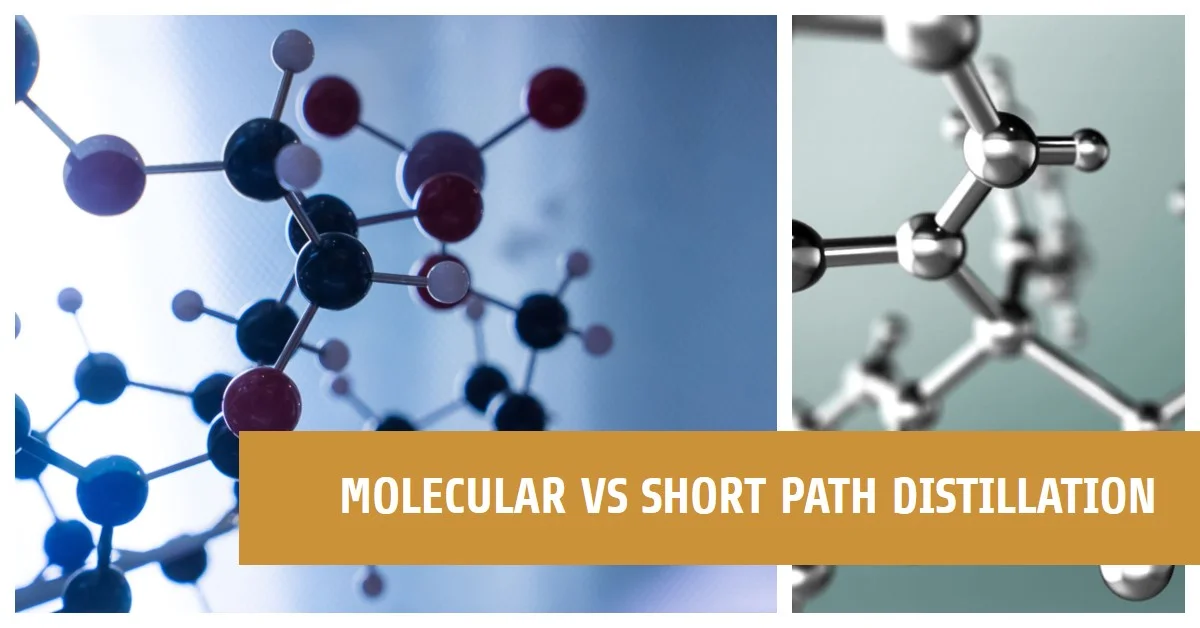Difference Between Molecular Distillation and Short Path Distillation
As a chemical engineer, I would like to explain the differences between molecular distillation and short path distillation methods used in various product industries. Both methods are thermal separation processes, primarily aimed at thermally sensitive products. Mostly these techniques use in industries such as pharmaceuticals, food processing, and chemical manufacturing. This article will provide you with a clear understanding of both these methods, their unique characteristics, equipment used, key variables, pros and cons, safety concerns, and real-life applications.
What is the Difference Between Molecular Distillation and Short Path Distillation
Molecular Distillation

Molecular distillation, also known as molecular evaporation, is a special form of short path distillation where pressure is reduced even further, typically to less than 1×10-2 mbar. This process enables separation of volatile components at temperatures below their boiling points, thus minimizing thermal degradation.
Efficiency:
Molecular distillation is renowned for its high separation efficiency, especially when dealing with heat-sensitive or high-boiling substances. The short path and minimal residence time minimize thermal degradation, resulting in high-purity distillate.
Operating Parameters :
Molecular distillation typically operates under high vacuum conditions with temperatures ranging from 80°C to 250°C. The low operating pressure enables distillation at lower temperatures, preserving the integrity of the sample.
Unique Characteristics:
- Extremely low pressure
- Short residence time and low evaporation temperature
- Minimal thermal stress on the product
Equipment Required:
- Molecular evaporator
- Feed and distillate pumps
- Cold traps and condensers
- Vacuum pumps or systems
Key Variables:
- Pressure
- Evaporation temperature
- Flow rate
Pros:
- Gentle on thermally sensitive products
- High separation efficiency
- No need for additional solvents
Cons:
- Limited to small-scale applications
- Higher equipment cost
- Complex operation and maintenance
Safety Concerns:
- Risk of leakage and contamination
- Handling of volatile components
Real-life Applications:
Molecular distillation is commonly used in the production of high-quality essential oils, pharmaceuticals (CBD distillation), and nutraceuticals (omega-3 fatty acids).
Short Path Distillation

Short path distillation, on the other hand, is a simple form of vacuum distillation where the vapor is condensed immediately after crossing the shortest possible distance between the evaporator and the condenser. This process is suitable for moderate vacuum levels, with pressures ranging from 1 to 10 mbar.
Efficiency:
Short path distillation offers excellent separation efficiency for substances with close boiling points. Its design reduces the pressure drop, ensuring minimal thermal degradation and increased purity of the distillate.
Short Path Distillation:
Short path distillation operates at a lower vacuum compared to molecular distillation, typically ranging from 0.001 to 0.1 mbar. The operating temperature could vary between 150°C to 350°C.
Unique Characteristics:
- Moderate vacuum levels
- Short distance between evaporator and condenser
- Less suited for highly heat-sensitive products
Equipment Required:
- Short path evaporator
- Feed and condensate pumps
- Vacuum pumps or systems
Key Variables:
- Pressure
- Evaporation temperature
- Feed flow rate

Pros:
- Lower equipment cost
- Easier operation and maintenance
- High separation efficiency
Cons:
- Limited to low boiling point components
- Moderate thermal stress on the product
Safety Concerns:
- Vacuum leaks
- Handling of potentially hazardous components
Real-life Applications:
Short path distillation is employed in the purification of organic compounds, perfume manufacturing, and refining edible oils.
Bottom Line
Here is the table summarizing the difference between molecular distillation and short path distillation:
| Aspect | Molecular Distillation | Short Path Distillation |
|---|---|---|
| Vacuum Pressure | Extremely low vacuum pressure (0.01 torr or below) | Reduced pressure |
| Technique Type | Short path vacuum distillation technique | Distillation technique |
| Distance Traveled | Short distance (about 2 cm) | Short distance |
| Application | Separation, purification, concentration of components in mixtures, purification of natural products, thermally sensitive molecules | Separation and purification of compounds, stability of compounds at lower temperatures |
| Losses | Minimizes losses due to thermal decomposition | Ensures minimal compound loss on apparatus sides |
| Compound Stability | Suitable for thermally sensitive molecules | Useful for compounds not stable at high temperatures |
In conclusion, molecular distillation and short path distillation are both widely used in various product industries to separate and purify thermally sensitive products. Molecular distillation offers a more gentle process due to its extremely low pressures and short residence times but is limited to small-scale applications. On the other hand, short path distillation can handle larger quantities with easier operation but may not be ideal for highly heat-sensitive products. Understanding the differences between these two techniques, their pros and cons, and appropriate applications benefits both industry professionals and the general public in making well-informed decisions when selecting the most suitable method for specific production goals.



